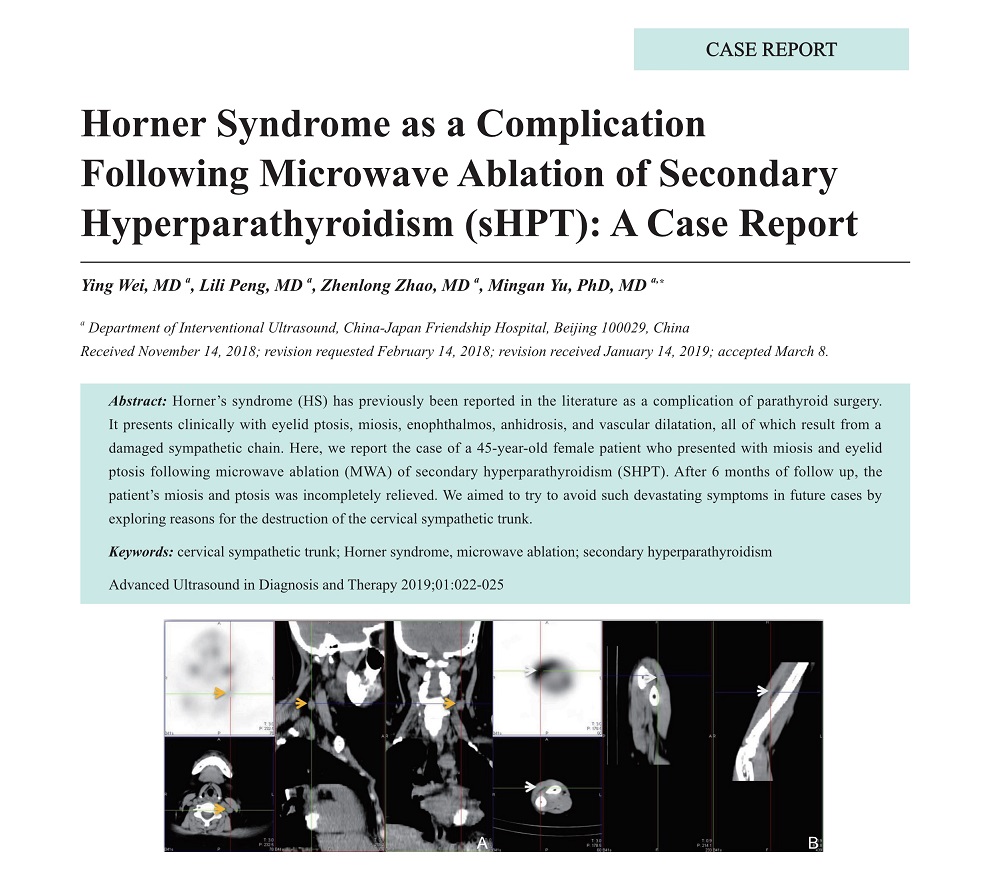

ADVANCED ULTRASOUND IN DIAGNOSIS AND THERAPY >
Horner Syndrome as a Complication Following Microwave Ablation of Secondary Hyperparathyroidism (sHPT): A Case Report
Received date: 2018-11-14
Online published: 2019-03-30
Horner’s syndrome (HS) has previously been reported in the literature as a complication of parathyroid surgery. It presents clinically with eyelid ptosis, miosis, enophthalmos, anhidrosis, and vascular dilatation, all of which result from a damaged sympathetic chain. Here, we report the case of a 45-year-old female patient who presented with miosis and eyelid ptosis following microwave ablation (MWA) of secondary hyperparathyroidism (SHPT). After 6 months of follow up, the patient’s miosis and ptosis was incompletely relieved. We aimed to try to avoid such devastating symptoms in future cases by exploring reasons for the destruction of the cervical sympathetic trunk.

Wei, MD Ying , Peng, MD Lili , Zhao, MD Zhenlong , Yu, PhD, MD Mingan . Horner Syndrome as a Complication Following Microwave Ablation of Secondary Hyperparathyroidism (sHPT): A Case Report[J]. ADVANCED ULTRASOUND IN DIAGNOSIS AND THERAPY, 2019 , 3(1) : 22 -25 . DOI: 10.37015/AUDT.2019.190805
| [1] | Y Kong YX, Wright G, Pesudovs K, O'Day J, Wainer Z, Weisinger HS. Horner syndrome. Clin Exp Optom 2007; 5:336-44. |
| [2] | Cheng Z, Che Y, Yu S, Wang S, Teng D, Xu H, et al. US-Guided Percutaneous Radiofrequency versus Microwave Ablation for Benign Thyroid Nodules: A Prospective Multicenter Study. Sci Rep 2017; 1:9554 |
| [3] | Yue W, Chen L, Wang S, Yu S. Locoregional control of recurrent papillary thyroid carcinoma by ultrasound-guided percutaneous microwave ablation: aprospective study. Int J Hyperthermia 2015; 4:403-408. |
| [4] | Zhuo L, Peng LL, Zhang YM, Xu ZH, Zou GM, Wang X, et al. US-guided Microwave Ablation of Hyperplastic Parathyroid Glands: Safety and Efficacy in Patients with End-Stage Renal Disease-A Pilot Study. Radiology 2017; 2:576-584. |
| [5] | Liu C, Wu B, Huang P, Ding Q, Xiao L, Zhang M, et al. US-Guided Percutaneous Microwave Ablation for Primary Hyperparathyroidism with Parathyroid Nodules: Feasibility and Safety Study. J Vasc Interv Radiol 2016; 6:867-75. |
| [6] | Harding JL, Sywak MS, Sidhu S, Delbridge LW. Horner’s syndromein association with thyroid and parathyroid disease. ANZ J Surg 2004; 6:442-5. |
| [7] | Zhang X, Ge Y, Ren P, Liu J, Chen G. Horner syndrome as a complication after thyroid microwave ablation: Case report and brief literature review. Medicine (Baltimore) 2018; 34:e11884. |
| [8] | Kanagalingam S, Miller NR. Horner syndrome: clinical perspectives. Eye Brain 2015; 7:35-46. |
| [9] | Ha EJ, Baek JH, Lee JH. Ultrasonography-Based Thyroidal and Perithyroidal Anatomy and Its Clinical Significance. Korean J Radiol 2015; 4:749-766 |
| [10] | Shin JE, Baek JH, Ha EJ, Choi YJ, Choi WJ, Lee JH. Ultrasound features of middle cervical sympathetic ganglion. Clin J Pain 2015; 10:909-13. |
/
| 〈 |
|
〉 |